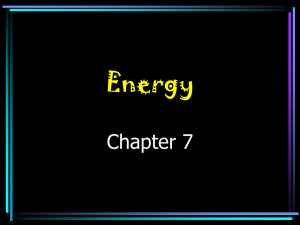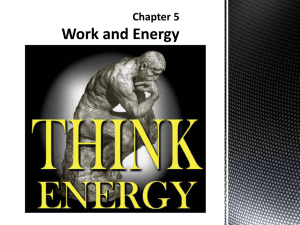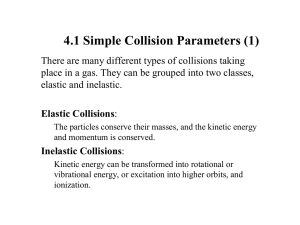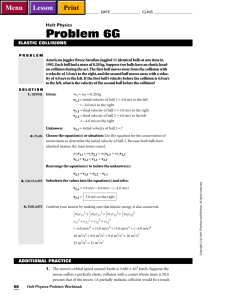Energy
advertisement
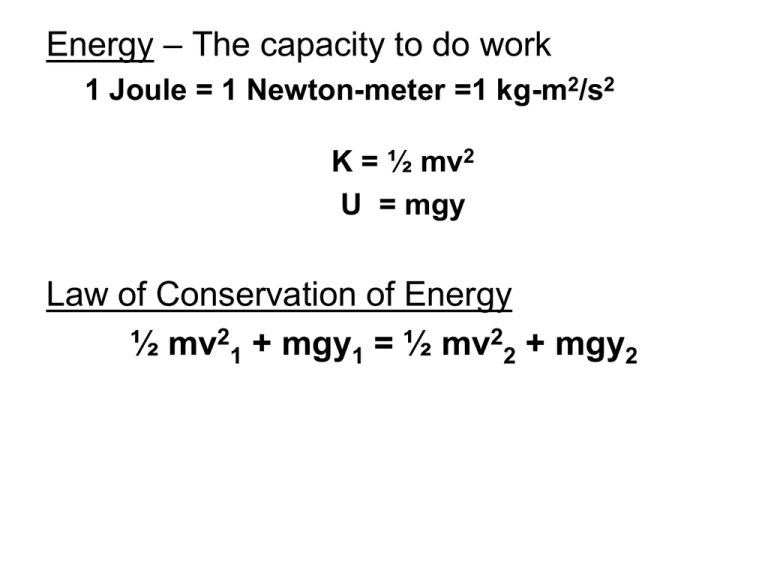
Energy – The capacity to do work 1 Joule = 1 Newton-meter =1 kg-m2/s2 K = ½ mv2 U = mgy Law of Conservation of Energy ½ mv21 + mgy1 = ½ mv22 + mgy2 Mr. Fredericks throws a 20.0 g pebble straight up with a speed of 25 m/s. What an afternoon of fun! a. Calculate the maximum height of the pebble. (32 m) b. Calculate the speed at which it returns to Mr. Fredericks’ hands. Mr. Fredericks (100 kg) jumps from a 3 meter cliff. Calculate his velocity when he is: a) 2 m above the ground b) 1 m above the ground c) Just before he hits (0 m) Assume the roller coaster car has a mass of 1000 kg. Calculate: a) U gained from A B (9.8 x 104 J) b) Total U at point B (2.45 x 105 J) c) Speed at C. (22.1 m/s) d) At what height will it have half the speed as at C? () A child runs at 2.0 m/s and jumps onto her sled. The sled is at the top of a 5.0 m hill. a. Calculate her speed at the bottom. Ballistic Pendulum Used to determine velocities Perfectly Inelastic collisions (KE converts to PE) Perfectly Inelastic Collision: Ex 3 A 5.00 gram bullet is fired into a 1.00 kg block of wood. The wood-bullet system rises 5 cm. Calculate the initial velocity of the bullet. m1v1 + m2v2 = m1v1’ + m2v2’ m1v1 + m2v2 = (m1 + m2)vf 0 +(0.005 kg)(vi) = (1.00 kg + 0.005 kg)(vf) (0.005 kg)(vi) = (1.005 kg)(vf) Moment of impact We need a second equation (two unknowns) ½ mv21 + mgy1 = ½ mv22 + mgy2 ½(1.005 kg)(vf2) +0 =0 + (1.005 kg)(9.8 m/s2)(0.05 m) vf = 0.990 m/s (0.005 kg)(vi) = (1.005 kg)(0.990 m/s) vi = 199 m/s A 10.0 g bullet is fired into a 1.20 kg ballistic pendulum. The bob rises to an angle of 40o. The string on the pendulum is 150 cm. a. Calculate the height that the pendulum rose. (35.1 cm) b. Calculate the initial speed of the bullet. (320 ms/) An 8.00 g bullet is fired at 350 m/s into a ballistic pendulum bob of 2.00 kg. Calculate how high the coupled bullet and bob will rise. Hooke’s Law for Springs F = -kx F = weight of an object k = spring constant (N/m) x = displacement when the object is placed on the spring A mass of 25 grams is placed on a spring. The spring stretches 6.00 cm from the equilibrium position. a. Calculate the spring constant. (4.1 N/m) b. Calculate how far the spring would stretch if 100 grams were placed in the spring. (23.9 cm) A 2.00 kg block is attached to a toy train that moves at 5.0 cm/s. The block is attached by a spring with spring constant of 50 N/m and the ms = 0.60. a. Derive a formula that indicates at what length the block will slip. b. Calculate the length the spring will stretch before slipping. (23.5 cm) c. Calculate the time at which that will occur. (4.7 s) Springs • U = ½ kx2 • Springs are a way to store potential energy ½ mv2 + mgy + ½ ky2 = ½ mv2 + mgy + ½ky2 A 10.0 g toy dart is compresses a spring 6.0 cm. The spring’s constant is 10.0 N/m. What speed will the dart leave the gun? (1.90 m/s) A 2.60 kg ball is dropped. It falls 55.0 cm before hitting a spring. It compresses the spring 15.0 cm before coming to rest. Calculate the spring constant. 55.0 cm -15.0 cm A 2.00 kg block is placed on top of a 2.00 m spring with a spring constant of 50,000 N/m. The spring is cranked down 80.0 cm and released. How high will the block go? (1800 m) A vertical spring has a spring constant of 450 N/m and is mounted on the floor. A 0.30 kg block is dropped from rest and compresses the spring by 2.50 cm. Calculate the height from which the block was dropped. Use the unstretched spring length as your zero point. (2.28 cm) A vertical spring has a spring constant of 895 N/m is compressed by 15.0 cm. a) Calculate the upward speed can it give to a 0.360 kg ball when released. (7.28 m/s) b) Calculate how high above the top of the uncompressed spring the ball will fly. (2.70 m) A 1.0 kg block and a 2.0 kg block are connected by a 2000 N/m spring. a. If the spring is compressed by 10 cm, calculate the velocity of each block as it flies apart. (Hint: use momentum and conservation of energy) (3.6 m/s, 1.8 m/s) Elastic Collisions • Both KE and momentum are conserved m1v1i + m2v2i = m1v1f + m2v2f v1i + v1f = v2i + v2f Elastic Collisions: Example 1 A cue ball moving at 2.0 m/s strikes the red ball. What is the speed of both balls after the elastic collision if they have equal mass? Elastic Collisions: Example 2 Two pool balls of equal mass collide. One is moving to the right at 20 cm/s, and the other to the left at 30 cm/s. Calculate their velocities after they collide elastically. +20 cm/s -30 cm/s Elastic Collisions: Example 3 A proton of mass 1.01 amu moving at 3.60 X 104 m/s elastically collides head on with a still Helium nucleus (4.00 amu). What are the velocities of the particles after the collision? Elastic collisions: Example 4 A 238 U atom decays into two small “daughter” nuclei. The lighter one is going east at 1.50 X 107 m/s, and the heavier one west at 2.56 X 105 m/s. Calculate the mass of each fragment. Assume they both add to 238 A 200.0 g steel ball hangs from a 1.00 m long string. The ball is released from a 45o angle and strikes a 500 g block (neglect friction). a. Calculate the distance the ball will drop before hitting the block. (29.3 cm) b. Calculate the speed at which the ball will hit the block. (2.40 m/s) c. Calculate the velocity of the ball and block after the collision. Assume an elastic collision. (-1.03 and +1.37 m/s) d. Calculate the angle the ball swings back to (19o)




